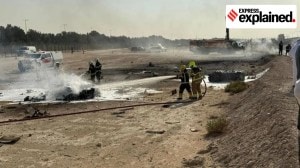A land-locked’ city all at sea
The navy has an interesting definition for a persistent malady that has afflicted this country down the ages - it's called the Continenta...

The navy has an interesting definition for a persistent malady that has afflicted this country down the ages – it’s called the Continental Theory, a land-locked mindset which results in sea-blindness.
While this malaise cost this country its freedom three centuries ago, a scaled-down, if less dramatic version, could now be used to explain the abysmal state of the city’s water transport system.
Mumbai’s linear geographical profile perhaps makes it the only one in the world with the town centre and the residential areas scattered at two ends.
But its island character also makes it the city in the country most favoured for a quick and efficient water transport system. Which makes the absolute lack of vision on the part of the state government even more startling.Successive studies from the early 70s, including one by the Vice-Admiral Dutta committee in 1983, have predicted that the sea offered fantastic growth potential and could aid in decongesting the city.
But that hasn’t happened so far. Even as thestate government continues inflicting flyover after flyover on the city as part of its Rs 1,550 crore programme, 11 commissioned at last count, the lack of any foresight for a comprehensive sea transport programme is bewildering.
“When the Nariman Point-Bandra link road is completed, we can reach the airport from south Mumbai in less than 20 minutes,” PWD Minister Nitin Gadkari boasted at the commissioning of flyover number 11 at Mahim. The cost of this entire West Island Freeway could easily be in the region of Rs 1,000 crore.
But as any hovercraft operator will tell you, a fast passenger seacraft could take somebody through the same distance in nearly the same time and at a considerably less cost. An entire scheme to build jetties with access roads and buy the craft could be accomplished in half the cost of the freeway.
With crush-dense capacity trains and sardine-can buses ferrying over six million commuters in the daily 9-to-5 north-south grind, the government is going slow on an opportunity toopen up a third front in the war against the ever increasing commuter-load.
So what has the state government done to encourage water transport? Well, four years ago it asked the private companies to go right ahead buying the costly hovercraft and begin ferrying passengers. The vital infrastructure, mainly jetties and roads leading to them, would be taken care of later. In the best traditions of Laloo Yadav’s new government in five minutes’ assurance. As one bitter hovercraft operator said, it was like asking private air taxis to start services, the airports would be built later!
Predictably the infrastructure didn’t appear and the hovercraft companies who had to offload disgruntled passengers on sandy beaches, way off their destinations, shut shop. So for nearly a year, water transport on the city’s eastern and western coasts has been non-existent.
Last year, the Maharashtra Maritime Board (MMB) floated tenders inviting private sector participation in a Build-Own-Operate-Transfer (BOOT) scheme.However, this scheme is still awaiting cabinet approval.
The bane of all urban traffic congestion and pollution has been the motor car, with the aim of all public transport being to remove the maximum number of cars off the roads.
A holidaying member of Mumbai’s alleged car lobby recently recounted how he zipped between Alibag and Colaba twice in a single day using a catamaran, to be able to sign some important papers. If there was a similar service to the suburbs he wouldn’t mind trading his car in for it, he confessed. In fact he would mind moving house to Alibag.
And it’s not just fast passenger transport that the waterways offer. A scheme proposed by the Inland Waterways Authority of India (IWAI) seven years ago envisaged transporting trucks directly from the entry points in the city at Dahisar, Thane and Vashi to the ports using Ro-Ro barges (roll on roll off). Besides eliminating the massive truck traffic entering and leaving the city, a staggering two trucks a minute, the scheme entails fuelsavings of 10 million litres. Not to mention truck-free roads in the city. All this for a little over Rs 200 crore. This scheme too is still under consideration’ by the state government. A dangerous phrase when you consider the rapidly exploding transport scenario.
But jetties and hovercraft aren’t the concrete and visible symbols of political achievement that the behemoths dotting the city are. They make even tinier political mileage, and therein lies the crunch. With less than eight months to go for the polls, water transport has evidently lost out in what’s turning out to be a fast and desperate election endgame.
Sandeep Unnithan is a senior reporter with The Indian Express. He covers infrastructure



- 01
- 02
- 03
- 04
- 05




























